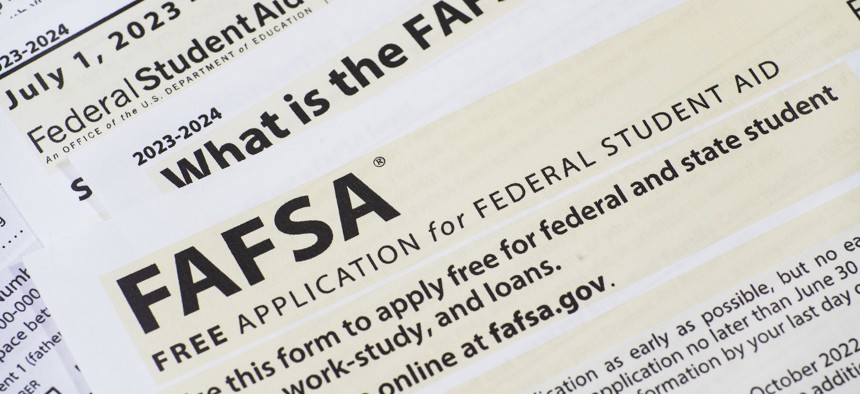Education Dept. debuts simpler online financial aid form, but users face a restricted rollout

Richard Stephen/Getty Images
The redesigned form features as few as 18 questions instead of potentially more than 100.
The Education Department unveiled its long-awaited update to the application for federal student aid, commonly known as the FAFSA, late last week.
The soft launch is meant to allow the department to fix “minor issues” discovered in the application, monitor the site and update the form. For students and families, that means the form won’t always be available online as the department pauses access for maintenance and updates. Education also says some users may be routed to a waiting room feature meant to control website volume.
An Education Department spokesperson told Nextgov/FCW that as of 12:30 p.m. on Jan. 4, 2024, there have been over 450,000 submissions.
"The department plans to continue the soft launch of the 2024-25 FAFSA form until we resolve issues uncovered through real-world user experience during the application soft opening,” a department spokesperson told Nextgov/FCW, and noted that rolling out new items gradually is “standard” for online tools and products and allows the department to make updates as issues are found.
The intention moving forward is to make the windows when the form is accessible longer, they said. On Friday, it is scheduled to be live from 8 a.m. to 8 p.m.
The overhaul is intended to make the process of filling out FAFSA applications easier. It’s the result of both the FAFSA Simplification Act, a federal student aid overhaul passed in 2020 as part of the 2021 appropriations law, as well as the Fostering Undergraduate Talent by Unlocking Resources for Education Act, passed in 2019.
Because of the FUTURE Act, the new form enables users to opt for a direct transfer of their tax information from the IRS into the application, an opt-in required to get federal student aid.
It’s an update from the old process that required users to go to the IRS website and input their information to be able to transfer their data.
That direct data exchange is also “an example of how data sharing makes it possible for government to ease burdens on the public,” Don Moynihan — chair of the McCourt School of Public Policy at Georgetown and an expert on administrative burdens and government reform — told Nextgov/FCW via email. “This is the promise of the FUTURE Act, and we are starting to see it pay off.”
He noted that the Privacy Act — which governs how federal agencies store and use personal information about people — dates to the 1970s and requires Congress to pass legislation for an agency to be able to use IRS data.
The new form is also a lot shorter.
Now, applicants only see questions relevant to them, based on the answers they’ve given so far. Applicants will be able to skip up to 26 questions, bringing the total tally down to as few as 18 questions for some. By contrast, last year’s form featured up to 103 possible questions.
The department is also touting changes to student aid calculations the administration says could make over 600,000 low-income students eligible for Pell Grants for the first time and make others newly eligible for the maximum award amount.
“When students and families fill out the better FAFSA form, they will find that applying for college financial aid is simpler, easier and faster than ever before,” said Secretary of Education Miguel Cardona in a November statement about the changes, calling them “the most significant overhaul of the federal financial aid application since the Reagan era.”
Thus far, some users are reportedly frustrated with glitches, the delay in its release and uncertainty around how the process will play out.
The timing of the launch could squeeze timelines for students approaching College Decision Day on May 1, although the Education Department is telling families that they don’t need to rush to fill out the form, as it will be sending schools the data later this month. Typically, the FAFSA comes out in October.
"Even by soft-launch standards, this weekend’s rollout was challenging,” Justin Draeger, president of the National Association of Student Financial Aid Administrators, said in a statement this week. “Students, families, and financial aid administrators who have been waiting for this release for months are understandably frustrated.”
“We know the Department of Education is working to bring the FAFSA online 24/7, but until that happens, and until we know more details about when schools will begin receiving finalized applicant data, schools cannot provide realistic timelines about when students and families will receive financial aid offers,” he said.
Scott Gerber, parent of a college-bound teen in Arlington, Va., told Nextgov/FCW that he was apprehensive about the form, given “horror stories” he’d heard from his mom and mother-in-law about their experience with filling out the FAFSA.
Gerber had been waiting for the form, checking on Dec. 1 to find that it wasn’t yet released and on Jan. 1, where he wasn’t able to access it as part of the soft launch.
He got in on Jan. 3 and filled it out in about 20 minutes. It was “very simple and straightforward,” especially in comparison to another financial aid application required by some colleges called the CSS profile, he said.






